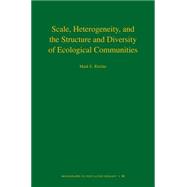
Note: Supplemental materials are not guaranteed with Rental or Used book purchases.
Purchase Benefits
Looking to rent a book? Rent Scale, Heterogeneity, and the Structure and Diversity of Ecological Communities [ISBN: 9781400831685] for the semester, quarter, and short term or search our site for other textbooks by Ritchie, Mark E.. Renting a textbook can save you up to 90% from the cost of buying.
| Acknowledgments | p. vii |
| Community Ecology Lives | p. 1 |
| The Geometry of Heterogeneity | p. 15 |
| Scaling Relationships for the Consumption of Resources | p. 32 |
| Food, Resources, and Scale-Dependent Niches | p. 56 |
| Size Structure in Ecological Guilds | p. 84 |
| Heterogeneity and Patterns of Species Diversity | p. 122 |
| Biodiversity Conservation in Fractal Landscapes | p. 148 |
| Testing the Model | p. 170 |
| Perspectives, Caveats, and Conclusions | p. 179 |
| Appendix-Summary of Model Parameters | p. 203 |
| References | p. 207 |
| Index | p. 227 |
| Table of Contents provided by Publisher. All Rights Reserved. |
The New copy of this book will include any supplemental materials advertised. Please check the title of the book to determine if it should include any access cards, study guides, lab manuals, CDs, etc.
The Used, Rental and eBook copies of this book are not guaranteed to include any supplemental materials. Typically, only the book itself is included. This is true even if the title states it includes any access cards, study guides, lab manuals, CDs, etc.